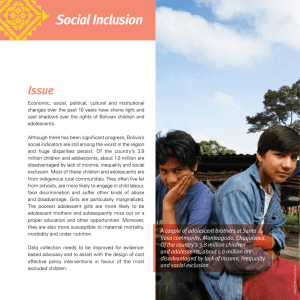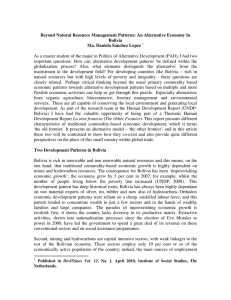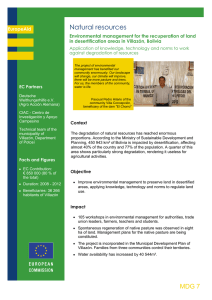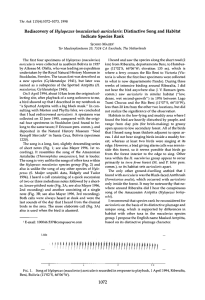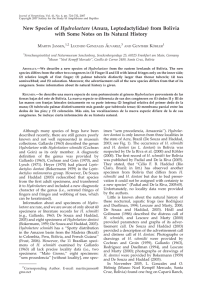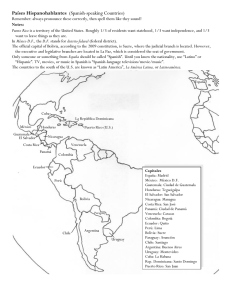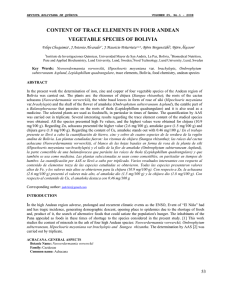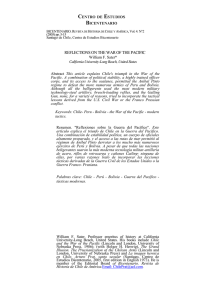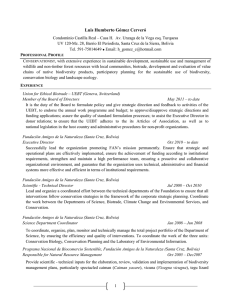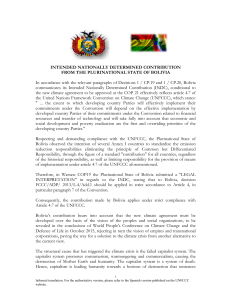Print LATEST COTINGA 22
Anuncio
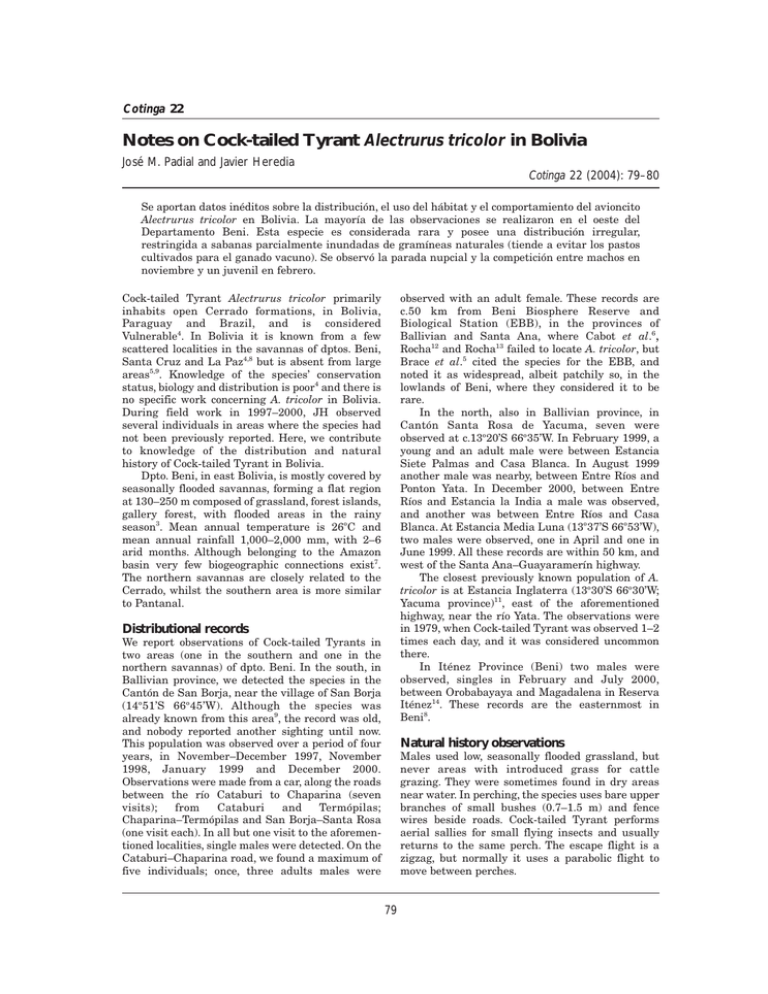
Cotinga 22 Notes on Cock-tailed Tyrant Alectrurus tricolor in Bolivia José M. Padial and Javier Heredia Cotinga 22 (2004): 79–80 Se aportan datos inéditos sobre la distribución, el uso del hábitat y el comportamiento del avioncito Alectrurus tricolor en Bolivia. La mayoría de las observaciones se realizaron en el oeste del Departamento Beni. Esta especie es considerada rara y posee una distribución irregular, restringida a sabanas parcialmente inundadas de gramíneas naturales (tiende a evitar los pastos cultivados para el ganado vacuno). Se observó la parada nupcial y la competición entre machos en noviembre y un juvenil en febrero. Cock-tailed Tyrant Alectrurus tricolor primarily inhabits open Cerrado formations, in Bolivia, Paraguay and Brazil, and is considered Vulnerable4. In Bolivia it is known from a few scattered localities in the savannas of dptos. Beni, Santa Cruz and La Paz4,8 but is absent from large areas5,9. Knowledge of the species’ conservation status, biology and distribution is poor4 and there is no specific work concerning A. tricolor in Bolivia. During field work in 1997–2000, JH observed several individuals in areas where the species had not been previously reported. Here, we contribute to knowledge of the distribution and natural history of Cock-tailed Tyrant in Bolivia. Dpto. Beni, in east Bolivia, is mostly covered by seasonally flooded savannas, forming a flat region at 130–250 m composed of grassland, forest islands, gallery forest, with flooded areas in the rainy season3. Mean annual temperature is 26o C and mean annual rainfall 1,000–2,000 mm, with 2–6 arid months. Although belonging to the Amazon basin very few biogeographic connections exist7. The northern savannas are closely related to the Cerrado, whilst the southern area is more similar to Pantanal. observed with an adult female. These records are c.50 km from Beni Biosphere Reserve and Biological Station (EBB), in the provinces of Ballivian and Santa Ana, where Cabot et al.6, Rocha12 and Rocha13 failed to locate A. tricolor, but Brace et al.5 cited the species for the EBB, and noted it as widespread, albeit patchily so, in the lowlands of Beni, where they considered it to be rare. In the north, also in Ballivian province, in Cantón Santa Rosa de Yacuma, seven were observed at c.13o 20’S 66o 35’W. In February 1999, a young and an adult male were between Estancia Siete Palmas and Casa Blanca. In August 1999 another male was nearby, between Entre Ríos and Ponton Yata. In December 2000, between Entre Ríos and Estancia la India a male was observed, and another was between Entre Ríos and Casa Blanca. At Estancia Media Luna (13o 37’S 66o 53’W), two males were observed, one in April and one in June 1999. All these records are within 50 km, and west of the Santa Ana–Guayaramerín highway. The closest previously known population of A. tricolor is at Estancia Inglaterra (13o 30’S 66o 30’W; Yacuma province)11, east of the aforementioned highway, near the río Yata. The observations were in 1979, when Cock-tailed Tyrant was observed 1–2 times each day, and it was considered uncommon there. In Iténez Province (Beni) two males were observed, singles in February and July 2000, between Orobabayaya and Magadalena in Reserva Iténez14. These records are the easternmost in Beni8. Distributional records We report observations of Cock-tailed Tyrants in two areas (one in the southern and one in the northern savannas) of dpto. Beni. In the south, in Ballivian province, we detected the species in the Cantón de San Borja, near the village of San Borja (14o 51’S 66o 45’W). Although the species was already known from this area9, the record was old, and nobody reported another sighting until now. This population was observed over a period of four years, in November–December 1997, November 1998, January 1999 and December 2000. Observations were made from a car, along the roads between the río Cataburi to Chaparina (seven visits); from Cataburi and Termópilas; Chaparina–Termópilas and San Borja–Santa Rosa (one visit each). In all but one visit to the aforementioned localities, single males were detected. On the Cataburi–Chaparina road, we found a maximum of five individuals; once, three adults males were Natural history observations Males used low, seasonally flooded grassland, but never areas with introduced grass for cattle grazing. They were sometimes found in dry areas near water. In perching, the species uses bare upper branches of small bushes (0.7–1.5 m) and fence wires beside roads. Cock-tailed Tyrant performs aerial sallies for small flying insects and usually returns to the same perch. The escape flight is a zigzag, but normally it uses a parabolic flight to move between perches. 79 Cock-tailed Tyrant in Bolivia Cotinga 22 Most observations were of lone males, only twice was more than one observed: an adult male and a juvenile in February 1999 and, in November 1998, three rival males attempted to mate with a single female. Display consisted of acrobatic flights and calls. The female perched near each male, until finally choosing one. The other males continued displaying, unsuccessfully, and thereafter departed. Cock-tailed Tyrant was not observed in the campos rupestres of Beni10, although habitat appears suitable. We have also not found it in many others parts of the wet Beni savannas. Perhaps it possesses special habitat preferences that contribute to a fragmented distribution. In Noel Kempff Mercado National Park, adjacent to Beni, which belongs to the Amazonian-Cerrado region of dpto. Santa Cruz, the species is unknown despite intensive field work2. Available information is insufficient to determine the conservation status of Cock-tailed Tyrant in Bolivia, but it appears uncommon and of restricted distribution. More field work and compilation of the scattered unpublished information is needed. 5. Brace, R. C., Hornbuckle, J. & Pearce-Higgins, J. W. (1997) The avifauna of the Beni Biological Station, Bolivia. Bird Conserv. Intern. 7: 117–159. 6. Cabot, J., Serrano, P., Ibáñez, C. & Braza, F. (1986) Lista preliminar de aves y mamíferos de la reserva “Estación Biológica Beni”. Ecología en Bolivia 8: 37–44. 7. Hanagarth, W. & Beck, S. G. (1996) Biogeographie der Beni-Savannen (Bolivien). Geographische Rundschau 48: 662–668. 8. Hennessey, A. B., Herzog, S. K. & Sagot, F. (2003) Lista anotada de las aves de Bolivia. Quinta edición. Santa Cruz de la Sierra: Asociación Armonia/BirdLife International. 9. Parker, T. A., Castillo, V. A., Gell-Mann, M. & Rocha O., O. (1991) Records of new and unusual birds from northern Bolivia. Bull. Brit. Orn. Club 111: 120–138. 10. Parker, T. A. & Rocha, O. (1991) La avifauna del Cerro San Simón, una localidad de campo rupestre aislado en el departamento Beni, noreste boliviano. Ecología en Bolivia 17: 15–29. 11. Remsen, J. V. (1986) Aves de una localidad en la sabana húmeda del norte de Bolivia. Ecología en Bolivia 8: 21–35. 12. Rocha, O. (1988) Adición de especies a la avifauna de la Reserva de la Biosfera “Estación Biológica Beni”, Bolivia. Ecología en Bolivia 12: 13–15. 13. Rocha, O. (1990) Lista preliminar de aves de la Reserva de la Biosfera “Estación Biológica Beni”. Ecología en Bolivia 15: 57–68. 14. Ten, S., Liceaga, I., González, M., Jiménez, J., Torres, L., Vázquez, R., Heredia, J. & Padial, J. M. (2001) Reserva Inmovilizada Iténez: primer listado de vertebrados. Rev. Bol. Ecol. Conserv. Amb. 10: 81–110. Acknowledgements Our work was funded by Hombre y Naturaleza: Bolivia, and Asociación Amigos de Doñana, and partially by the project Conservación de la Biodiversidad y Ecodesarrollo en la Reserva Iténez (El Beni, Bolivia), founded by Gobierno Foral de Navarra (Spain) in collaboration with Prefectura del Beni (Bolivia). Thanks to Dr Javier Castroviejo and Manuel Español for their encouragement. Silvia Ten and Mario González helped in Beni. Students from San Borja assisted the field work, and the staff of Armonía are thanked, especially those who provided access to their database and bibliography. Sebastian Herzog critically reviewed an earlier draft of the manuscript. José M. Padial Museo de Historia Natural Noel Kemppf Mercado, Area de Zoología, Av. Irala 561, Casilla 2489, Santa Cruz de la Sierra, Bolivia. E-mail: jmpadial@yahoo.com. References 1. Armonía (1995) Lista de las aves de Bolivia. Cuarta edición. Santa Cruz de la Sierra: Armonía/BirdLife International. 2. Bates, J. M. & Parker, T. A. (1998) The avifauna of Parque Nacional Noel Kempff Mercado and surrounding areas. In: Killen, T. J. & Schulenberg, T. S. (eds.) A biological assessment of Parque Nacional de Noel Kempff Mercado, Bolivia. RAP Working Papers 10. Washington DC: Conservation International. 3. Beck, S. G., Killeen, T. J. & García, E. E. (1993) Vegetación de Bolivia. In: Killeen, T. J., García, E. E. & Beck, S. G. (eds.) Guía de árboles de Bolivia. La Paz: Herbario Nacional de Bolivia & St Louis: Missouri Botanical Garden. 4. BirdLife International (2000) Threatened birds of the world. Cambridge, UK: BirdLife International & Barcelona: Lynx Edicions. Javier Heredia C/ Sarbil, 1, 31174 Etxauri, Navarra, Spain. E-mail: jhfsevilla@hotmail.com. 80
